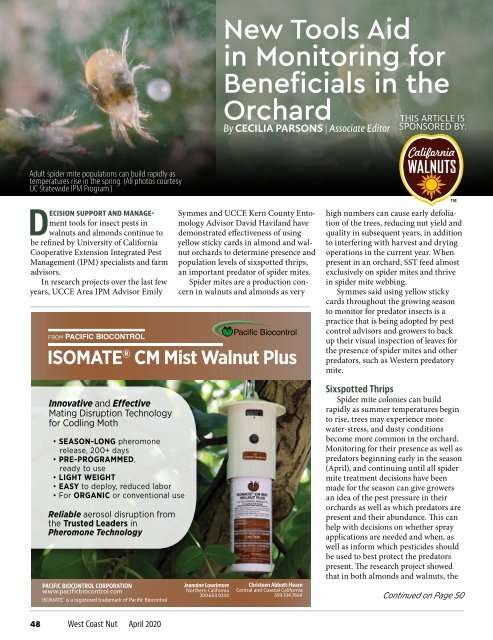Create successful ePaper yourself
Turn your PDF publications into a flip-book with our unique Google optimized e-Paper software.
New Tools Aid<br />
in Monitoring for<br />
Beneficials in the<br />
Orchard<br />
By CECILIA PARSONS | Associate Editor<br />
THIS ARTICLE IS<br />
SPONSORED BY:<br />
Adult spider mite populations can build rapidly as<br />
temperatures rise in the spring. (All photos courtesy<br />
UC Statewide IPM Program.)<br />
Decision support and management<br />
tools for insect pests in<br />
walnuts and almonds continue to<br />
be refined by University of California<br />
Cooperative Extension Integrated Pest<br />
Management (IPM) specialists and farm<br />
advisors.<br />
In research projects over the last few<br />
years, UCCE Area IPM Advisor Emily<br />
Symmes and UCCE Kern County Entomology<br />
Advisor David Haviland have<br />
demonstrated effectiveness of using<br />
yellow sticky cards in almond and walnut<br />
orchards to determine presence and<br />
population levels of sixspotted thrips,<br />
an important predator of spider mites.<br />
Spider mites are a production concern<br />
in walnuts and almonds as very<br />
ISOMATE ® CM Mist Walnut Plus<br />
high numbers can cause early defoliation<br />
of the trees, reducing nut yield and<br />
quality in subsequent years, in addition<br />
to interfering with harvest and drying<br />
operations in the current year. When<br />
present in an orchard, SST feed almost<br />
exclusively on spider mites and thrive<br />
in spider mite webbing.<br />
Symmes said using yellow sticky<br />
cards throughout the growing season<br />
to monitor for predator insects is a<br />
practice that is being adopted by pest<br />
control advisors and growers to back<br />
up their visual inspection of leaves for<br />
the presence of spider mites and other<br />
predators, such as Western predatory<br />
mite.<br />
Innovative and Effective<br />
Mating Disruption Technology<br />
for Codling Moth<br />
• SEASON-LONG pheromone<br />
release, 200+ days<br />
• PRE-PROGRAMMED,<br />
ready to use<br />
• LIGHT WEIGHT<br />
• EASY to deploy, reduced labor<br />
• For ORGANIC or conventional use<br />
Reliable aerosol disruption from<br />
the Trusted Leaders in<br />
Pheromone Technology<br />
PACIFIC BIOCONTROL CORPORATION<br />
www.pacificbiocontrol.com<br />
ISOMATE ® is a registered trademark of Pacific Biocontrol<br />
Jeannine Lowrimore<br />
Northern California<br />
209.603.9244<br />
Christeen Abbott-Hearn<br />
Central and Coastal California<br />
559.334.7664<br />
Sixspotted Thrips<br />
Spider mite colonies can build<br />
rapidly as summer temperatures begin<br />
to rise, trees may experience more<br />
water-stress, and dusty conditions<br />
become more common in the orchard.<br />
Monitoring for their presence as well as<br />
predators beginning early in the season<br />
(<strong>April</strong>), and continuing until all spider<br />
mite treatment decisions have been<br />
made for the season can give growers<br />
an idea of the pest pressure in their<br />
orchards as well as which predators are<br />
present and their abundance. This can<br />
help with decisions on whether spray<br />
applications are needed and when, as<br />
well as inform which pesticides should<br />
be used to best protect the predators<br />
present. The research project showed<br />
that in both almonds and walnuts, the<br />
Continued on Page 50<br />
48 West Coast Nut <strong>April</strong> <strong>2020</strong>


















